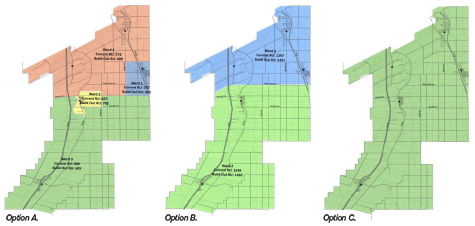As Manitoba’s towns, cities, and municipalities head into the new year, the province’s Municipal Finance and Advisory Services Branch has announced that the time has come for municipalities to conduct a review of their ward boundaries in advance of the 2018 general municipal election. Election Day is set for Wednesday, October 24, 2018.
All municipalities that have ward systems, such as Ritchot, need to review their ward boundaries following Canadian censuses. The 2016 census showed large population increases throughout Ritchot, and the current review is intended to ensure that the boundaries remain fair and balanced.
Section 88 of The Municipal Act states that “in dividing a municipality into wards and establishing ward boundaries, a council (a) must try to achieve an approximately equal number of residents in each ward; and (b) may take into consideration community or diversity of interests, topographical features, settlement patterns, and population trends.”
The reality is that Ritchot’s wards have not changed since 1998, when the boundaries were redrawn in response to the 1996 census, which showed a small increase in population from 5,146 to 5,364. In fact, the municipality’s population has remained relatively flat from 1991 until 2011, with the number fluctuating only by a few hundred people per census.
That all changed in 2016, however, when the population surged by almost 22 percent in a single census period. Last year’s census pegs the population at 6,679.
The result of this sudden growth is that the current ward populations are markedly uneven, with the greatest concentration in the Île-des-Chênes area.
Through a series of public consultations in late October and early November, the RM has identified three options for how to change the boundaries to even the distribution.
Option A
The first option would involve maintaining the current four-ward system, but moving the boundaries. The primary effect would be to shrink Ward 1 to encompass little more than Île-des-Chênes itself and cede its northern rural territory to Ward 4 (Grande Pointe) and some of its southern rural territory to Ward 3 (Ste. Agathe). Ward 2 (St. Adolphe) would remain unchanged.
This option is based on the projection that development in Île-des-Chênes is likely slowing down, and the population of the other wards is expected to pick up in the coming years.
Each ward would get one councillor, the same as the current system.
Option B
A second option would involve transitioning to a two-ward system—a northern ward encompassing Grande Pointe, Howden, and Île-des-Chênes and a southern ward encompassing St. Adolphe and Ste. Agathe. This would allow a very precise distribution of population between the two wards.
At last month’s open houses, it was noted that the two-ward system makes sense geographically, and the communities that most identify with each other would remain connected.
Each ward would get either two or three councillors each.
Option C
Perhaps most controversially, the third option under consideration is eliminating all wards and allowing the whole municipality to elect its council at-large. Every voter, regardless of where they live in the RM, would get to vote for each candidate for council, just as everyone currently gets a vote for mayor.
One effect would be a larger pool of candidates for voters to choose from. Another possible effect could be changing the number of councillors who sit on council. While the number is currently four, that could be subject to change.
A downside to the at-large system is that there would be no way to guarantee that each community has a local representative on council. Communities with larger populations might be able to overrule communities with lower populations, by virtue of their greater number of votes. The costs of campaigning for council would also likely increase, as candidates would have to campaign across the entire municipality as opposed to just their local ward.
“We really don’t have too many RMs at-large, so it is hard to weigh in on this,” says Ritchot Mayor Ewen. “As well, the consensus throughout the RM was at-large was not on their radar.”
Moving Forward
At their regularly scheduled meeting on November 22, all members of Ritchot’s council indicated that their constituents seem to be in agreement with Option A—maintaining four wards, but shifting the boundaries.
“The feeling from constituents during the open houses, and even just phone calls and emails, was to stick to the status quo, with only adjustments of the boundaries of each ward,” Ewen says.
A measure opting for shifting the boundaries of the four wards received its first reading at the November 22 meeting, and now a public hearing will take place on December 20. Members of the public are advised that this will be their opportunity to make their voices heard, if they haven’t been already.


